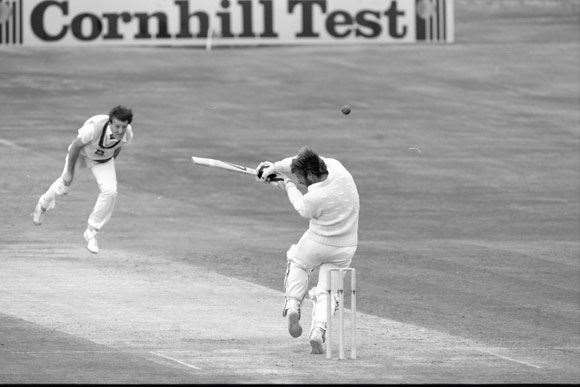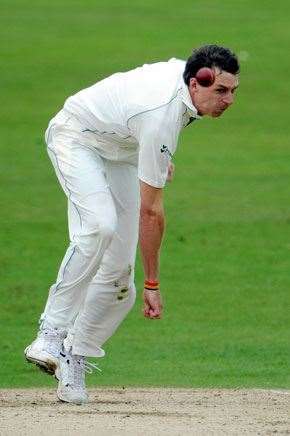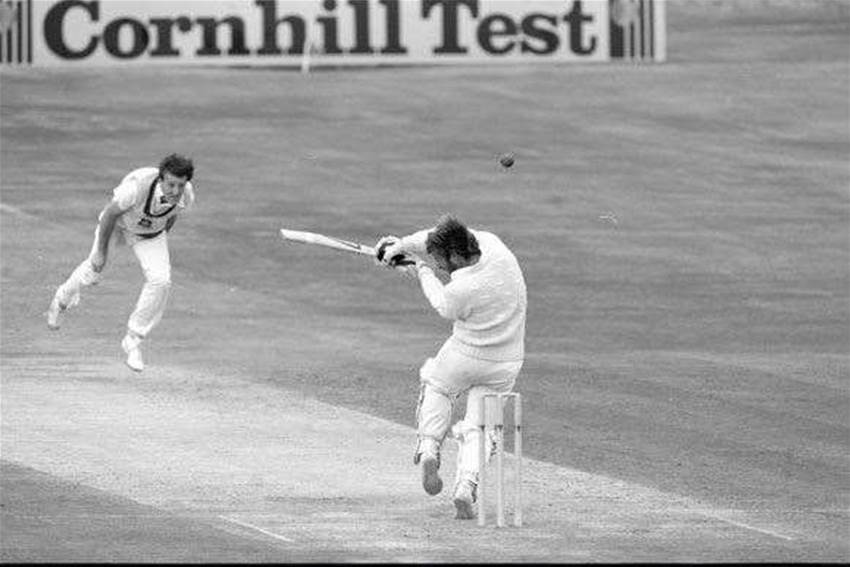It's difficult to find many chairs in the cricketing hierarchy that haven't been occupied by Geoff Lawson.
It’s difficult to find many chairs in the cricketing hierarchy that haven’t been occupied by Geoff Lawson.
 Lawson v Botham, Headingley, 1981. Ah, the good ol’ days.
Lawson v Botham, Headingley, 1981. Ah, the good ol’ days.Image: Getty Images
He spent a decade at pitch-level, garnering 180 Test scalps at the sharp end of Australia’s bowling attack throughout the ’80s. He skippered NSW over four seasons, winning the Sheffield Shield in his final summer. He sat in the commentary box, he spoke on radio, he wrote newspaper columns. And then he assumed the Pakistani coach’s throne in the wake of Bob Woolmer’s death. He led the Pakis to the final of the T20 World Cup, before being summarily flicked a year later when a new regime stormed PCB headquarters. On top of all that, he’s charming, cheerful and full of insight. Just the man to dissect Australia’s slide as the rampant Proteas cross the Indian Ocean
You coached Pakistan to a recent series loss against the Proteas. What are your predictions for this series?
South Africa are a good, tough cricket team. JP Duminy looks like he’ll be an outstanding batsman, and they’ve got such a good stock of quick bowlers, they’re looking to phase out Ntini. Their spin bowling? They’ll stick with Harris, but they’ll have a plan of how to use him. They’ll be a quality opponent and they won’t take any backward steps if Australia try the verbal on them. There’ll be clashes there. I think both teams are very evenly matched and if Australia doesn’t get its act together on some internal issues … Look, it could go either way. It’ll probably come down to a couple of great catches or a great innings or a great bowling spell.
Speaking of Australia’s internal issues, what are your thoughts on Ricky Ponting’s captaincy?
When you’ve got great players, it’s easy. Look at Clive Lloyd – throw the ball to a fast bowler and put everyone behind the wicket. You don’t have to “captain” those sort of teams. But with the loss of Warne, Gilchrist and McGrath, Ponting’s now being faced with challenges and he’s not meeting them. And he’s going to have more challenges coming up with South Africa and the Ashes. It’s going to be a highly stressful time.
Are his responses to these “challenges” too defensive?
Well, it’s a natural human reaction to be defensive. But to me, one of his biggest errors came after that fourth Test in India. Okay, he made a tactical error, but the fact that he couldn’t admit it, the fact he kept defending his decision, that’s a concern. His introspection needs to be a lot more detailed. What do they say? The first step to correcting a mistake is admitting you made one. And he’s not admitting he’s making mistakes. Good leaders are critical of themselves and he’s not being critical.
What about our bowling? Were you alarmed at how toothless our attack looked in India?
Yeah, they certainly didn’t look to have much penetration. They just tried to wear people down and then they didn’t have a quality spinner to come in and do a holding job, so after the first Test the Indian batsmen realised they just weren’t going to be challenged too much. I mean, even Mitchell Johnson’s 13 wickets in four Tests – that’s not bad for a stock bowler, but it’s not what you want from a strike bowler. Plus, he snagged a couple down leg side, and picked up a few tailenders. He never really threatened the top order. So yes, it’s a concern.
 Dale Steyn is the best of South Africa’s stock of young quicks.
Dale Steyn is the best of South Africa’s stock of young quicks.Image: Getty Images
Everyone talks about our dearth of spinners. Are we also lacking a world-class pace battery?
I think Australia’s tactics – particularly with Johnson – need to be reviewed because it’s quite apparent they just want him to go across right-handers and bowl to a seven-two field. So it’s a battle of patience rather than getting people out as quickly as you can. And with Australia making less runs, they can’t afford these tactics. And with Johnson’s wrist and arm position, he just isn’t going to tail them in to right-handers. It just isn’t going to happen. I mean, he’s got a good wrist position for reverse swing, and he didn’t even do that in India. They need to step back and let some people from outside look at it because, once again, their introspection is not working at the moment.
Are coaches still attached to the idea of replicating Glenn McGrath?
If they are, they’re not doing it very well. Look, the big picture is there’s no Warne and McGrath, who were outstanding bowlers who would tell you what the tactics are. Maybe the bowlers now need to tell the captain and coaching staff what tactics they should be using rather than the other way around. Bowlers need to be in charge of their modus operandi, they need to have input. Then they can believe what they do, rather than having a captain – who’s a batsman – telling them what to do all the time.
Have our quicks lost the ability to swing the ball?
The straight answer is yes. Even the Indians swung it more in India. Technically, the Australians just aren’t getting it right. Lee didn’t technically get it right in India, and he didn’t have the seam in a good enough position in Brisbane. Mitchell Johnson does not swing the ball into right-handers. He’s getting people out with persistence, letting them make errors rather than actually bowling people out. He doesn’t swing the ball at all because his hand’s low and his wrist release is terrible … So yes, our guys are technically not able to swing the ball because they don’t get the seam in the right spot. These things are solvable – Australia just aren’t concentrating on swinging the ball at the moment.
So you don’t see Mitchell Johnson as our next spearhead?
He’s certainly not a strike bowler. He’s not getting a lot of new ball wickets. He bowls with reasonable pace, bowls across the right-hander all the time, and then waits for batsmen to go hard at him. A classic example from the Brisbane Test was Ross Taylor, who was batting very well. He was running out of partners, so he drove hard at a wide one and nicked it. And that’s what the Australians want everyone to do. He’s just not getting quality players out often enough, so to suggest that he’s a strike bowler is not right. He’s a good stock bowler, but he’s limited in what he does. He’s not threatening quality top-order batsmen and he’s not getting early breakthroughs. Unfortunately for Australia, neither’s Brett Lee and that’s why they struggled against India. And if one person from New Zealand had made a century, they might have won that first Test, too.
 Blasting out the Masterblaster, Viv Richards. Image: Getty Images
Blasting out the Masterblaster, Viv Richards. Image: Getty ImagesWhat about the NSW left-arm quick, Doug Bollinger?
Well, he does swing it both ways and I thought he should’ve played in India, especially after they lost the second Test. Surely the selectors are analysing where they want to go with their game? They just seem to be sticking with people who aren’t producing, and Dougie is a bloke who’s got countless wickets in the last few seasons with balls moving in to the right-hander and away from left-handers. It’s time to give him a go.
Is Jason Krejza Australia’s spin bowling answer?
It’s been a promising start. When he was a young player in the NSW system, he drifted it, he turned and that’s why he was put in the state side. Bowling in Nagpur, he reminded me of a young Greg Matthews: throw the ball up, give it air, land it in the footmarks, and try to hit off-stump. He doesn’t have a great arm ball and he doesn’t have a doosra, but he threw it up and hit the footmarks and that worked in those conditions. Now he has to learn to bowl in Brisbane-style conditions. Matthews used to love bowling in Perth and Brisbane because he used different flight and he had different methods of getting people out.
As an old quick, you must’ve been cheering during the Brisbane Test against NZ to see ball dominate bat?
I’m pretty sure the Australian bowlers were happy to see it after they bowled on four roads in India. Fast bowlers like to turn up and see the ball carrying shoulder height rather than ankle height … But still, the game should’ve gone five days. Modern batting techniques just aren’t good enough for batsmen to bat for hours. An exception was Simon Katich, who let plenty of balls go and chose the ones to hit. People have to learn to score slower and they don’t have the mindset to do it any more. The pitch didn’t do that much, it just kept the bowlers interested. Look at the dismissals – how many people actually got out to good balls? Four or five out of 40? Everyone kept nicking balls they should’ve been letting go; Hayden going hard at balls outside off-stump, Ponting playing shots he shouldn’t have played …
The selectors have flagged a return to the “horses for courses” policy. What are your thoughts?
To me it just doesn’t make sense. I think the selectors confused themselves in India and they’re not getting any better. I mean, they play two all-rounders in Brisbane, but had NZ made another 150, it could’ve been a total backfire. We might’ve desperately needed a genuine spinner.They’ve changed what’s been a pretty successful policy for 130 years, and I’m afraid they might be out-thinking themselves. They certainly got it wrong in India.
 Geoff Lawson. Images: Aaron Scott
Geoff Lawson. Images: Aaron ScottHow does Australia fix their over rate dilemma?
There should not be an over rate problem. All you’ve got to do is get on with the game. It’s just become habitual – Australia plays the game slowly. Ponting is habitually slow. No one moves quickly between overs. Again, Australia’s introspection is poor. No one else in world cricket seems to be having these chronic over rate problems.Having said that, Brisbane was a seam bowling wicket, everyone was bowling seamers, and we were still only three overs down. I don’t think that’s a big deal because the match was all about seam bowling. You have to bowl to the conditions. The ICC have to be careful and make sure they don’t force people to bowl spinners when spin’s not appropriate. The quality of the game is more important than the quantity and that line needs to be drawn.
As a coach, how do you deal with a bloke like Shoaib Akhtar?
He’s a very interesting and mixed-up character who doesn’t listen to advice from anybody. That’s his problem. I said to him, “Once you can be truthful with me, I’ll deal with you. Until that time, I don’t want anything to do with you. I don’t want you in this team.” And he never reached that point. I had other enthusiastic, keen cricketers who needed my attention more than a 33-year-old who loves the media exposure more than he loves playing cricket.
The Australians seem to be constantly at loggerheads with the Indian team. How does the mentality and philosophy of sub-continental cricket differ to that in Australia?
I think it’s pretty similar in many ways. But let’s take the Symonds-Harbhajan issue. Over there everyone sees Symonds as a troublemaker
who started it all and they have sympathy with Harbhajan. Even the Pakistan players sided with Harbhajan because they see the Australians as having a history of bad behaviour. Australian players, over there, are respected incredibly for how they play cricket, but they’re not respected for how they behave. You know, Hayden’s not well liked over there – incredibly respected, but not well liked – because he just stands at first slip and abuses people. But over here we say, “Oh, that’s how we play, we play tough.” Well, the Indians decided to give it back to them and the Australians didn’t like it. And that doesn’t reflect well on the Australians. If you’re an outside observer, as I’ve been in Pakistan, then you see the Australians being challenged – both in how they play and how they behave – and they’ve responded very poorly.
Why do Pakistani teams reach their potential so rarely?
It’s a systemic problem and they’re suffering it right now. The previous chairman was doing a great job – trying to fund regional academies and a national academy, trying to give them a proper process they can work with – and the new administration has come in and pulled it all apart. So they were heading in the right direction, now it’s just dreadful. The budget’s cut, the academies have been dispensed with, and a great management team’s been destroyed. And that’s classic Pakistan. This is the way the system’s run: the chairman’s appointed by a politician and from there down it’s all jobs for the boys. It’s not a meritocracy in any shape or form. And that filters down to the selection of the team – I had to deal with it time and again – where they just don’t pick the best players. You know, they’ve got that much raw talent over there, it’s just ridiculous.
– Aaron Scott
Related Articles

Video interview: Drinks With ... Matt Millar

McIlroy turns to Butch Harmon ahead of Augusta berth













